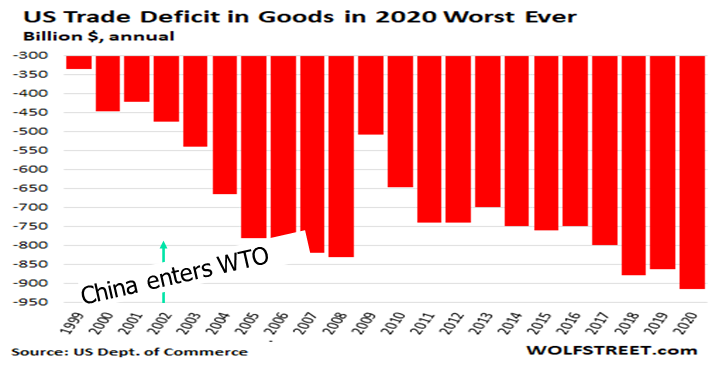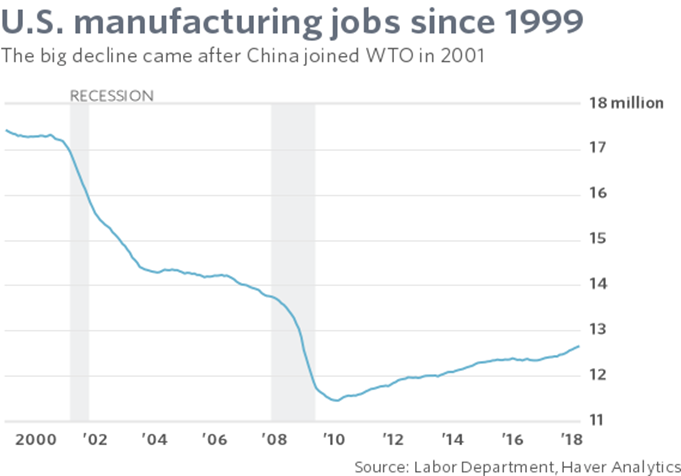On January 10, 2023, the House voted to pass a resolution “to create a select committee focused on U.S. competition with China, fulfilling a campaign promise Republicans made in the lead-up to the 2022 midterm elections.”
An article in The Hill, stated: “The select committee, chaired by Rep. Mike Gallagher (R-Wis.), will zero in on the Chinese Communist Party’s economic, technological and security progress and the strategic competition between Beijing and Washington. The resolution tasks the panel with investigating and submitting policy recommendations on those matters.” The Committee will be “made up of seven Republicans and five Democrats” and “has the authority to hold public hearings.”
The question that should be on everyone’s mind is — Will this Committee have any real impact when Congress has not taken any action on recommendations provided by the annual report they have received from the U.S.-China Economic and Security Review Commission for 20 years?. Will this Committee just be another “dog and pony” show to demonstrate that Congress is taking the threat China poses to the U.S. more seriously?
For those of you who have never heard of such a Commission, it “was created on October 30, 2000 by the Floyd D. Spence National Defense Authorization Act of 2001, Pub. L. No. 106–398 (codified at 22 U.S.C. §7002) …” This was after China was granted “Most Favored Nation” status, now known as Permanent Normal Trade Relations (PNTR) and allowed to become a member of the World Trade Organization by President Clinton.
The stated “purpose of the Commission is to monitor, investigate, and report to Congress on the national security implications of the bilateral trade and economic relationship between the United States and the People’s Republic of China. “
The main duty of the Commission is to provide an annual report to Congress — “Not later than December 1 each year (beginning in 2002), the Commission shall submit to Congress a report, in both unclassified and classified form, regarding the national security implications and impact of the bilateral trade and economic relationship between the United States and the People’s Republic of China. The report shall include a full analysis, along with conclusions and recommendations for legislative and administrative actions, if any, of the national security implications for the United States of the trade and current balances with the People’s Republic of China in goods and services, financial transactions, and technology transfers…”
Each report was required to include full discussion of key factors of the U.S.-China relationship that are very comprehensive. The following briefly summarizes the key factors:
(A) “The role of the People’s Republic of China in the proliferation of weapons of mass destruction and other weapon systems…”
(B) “The qualitative and quantitative nature of the transfer of United States production activities to the People’s Republic of China, including the relocation of manufacturing, advanced technology and intellectual property, and research and development facilities…”
(C) “The effects of the need for energy and natural resources in the People’s Republic of China on the foreign and military policies of the People’s Republic of China, the impact of the large and growing economy of the People’s Republic of China on world energy and natural resource supplies, prices, and the environment…”
(D) “Foreign investment by the United States in the People’s Republic of China and by the People’s Republic of China in the United States…”
(E) “The military plans, strategy and doctrine of the People’s Republic of China…and the implications of such objectives and trends for the national security of the United States.”
(F) “The strategic economic and security implications of the cyber capabilities and operations of the People’s Republic of China. “
(G) “The national budget, fiscal policy, monetary policy, capital controls, and currency management practices of the People’s Republic of China, their impact on internal stability in the People’s Republic of China, and their implications for the United States.”
(H) “The drivers, nature, and implications of the growing economic, technological, political, cultural, people-to-people, and security relations of the People’s Republic of China’s with other countries, regions, and international and regional entities…”
(I) “The compliance of the People’s Republic of China with its commitments to the World Trade Organization, other multilateral commitments, bilateral agreements signed with the United States, commitments made to bilateral science and technology programs, and any other commitments and agreements strategic to the United States (including agreements on intellectual property rights and prison labor imports), and United States enforcement policies with respect to such agreements.”
(J) “The implications of restrictions on speech and access to information in the People’s Republic of China for its relations with the United States in economic and security policy, as well as any potential impact of media control by the People’s Republic of China on United States economic interests.”
(K) “The safety of food, drug, and other products imported from China…”
The report was also required to “include recommendations for action by Congress or the President, or both, including specific recommendations for the United States to invoke Article XXI (relating to security exceptions) of the General Agreement on Tariffs and Trade 1994 with respect to the People’s Republic of China, as a result of any adverse impact on the national security interests of the United States. “
The 2022 Annual Report to Congress was submitted on November 15, 2022 to Patrick Leahy
President Pro Tempore of the U.S. Senate and Nancy Pelosi, Speaker of the U.S. House of Representatives. “The Commission conducted seven public hearings, taking testimony from 74 expert witnesses from government, the private sector, academia, think tanks, research institutions, and other
backgrounds.”
This report contained the following chapters:
Chapter 1 – CCP Decision-Making and Xi Jinping’s Centralization of Authority
Chapter 2 – U.S.-China Economic and Trade Relations
- Section 1 – U.S.-China Economic and Trade Relations
- Section 2 – Challenging China’s Trade Practices
- Section 3 – China’s Energy Plans and Practices
- Section 4 – U.S. Supply Chain Vulnerabilities and Resilience
Chapter 3 – U.S.-China Security and Foreign Affairs
- Section 1 – Year in Review: Security and Foreign Affairs
- Section 2 – China’s Cyber Capabilities: Warfare, Espionage, and Implications for the United States
- Section 3 – China’s Activities and Influence in South and Central Asia
Chapter 4 – Taiwan
Chapter 5 – Hong Kong
The report made 39 very specific recommendations for Congressional consideration to address the key factors covered in the above chapters of the report. The Executive Summary states: “The Commissioners agreed that ten of these recommendations, which appear on page 10, are the most important for congressional action.” However, the concluding comment of the Executive Summary states: “There remains a gap between America’s growing recognition of the challenges China presents and our responses to date in dealing with them. The purpose of this report is to assess recent developments and to recommend a set of actions that Congress can consider to help meet the challenges, and seize the opportunities they present.”
Space doesn’t permit considering the ten most important recommendations, but I will at quote the shortest recommendation as an example:
#7. “. Congress create an authority under which the president can require specific U.S. entities or U.S. entities operating in specific sectors to divest in a timely manner from their operations, assets, and investments in China, to be invoked in any instance where China uses or threatens imminent military force against the United States or one of its allies and partners.”
I’ve wondered for years if any Congressional Representative actually read the annual report because I never saw any actions taken by Congress with regard to the recommendations I read in the reports of 2008, 2011 and 2016 when I was writing my three books. It seems to me that the new select Committee on China should review the Commission’s 2022 report and propose legislation to act on the recommendations of the report instead of starting all over with holding hearings.
Our national security is at stake, and we don’t have time to “start from scratch” with a new committee conducting hearings to replicate the work that has already been done by the U.S.-China Economic and Security Review Commission. It would be a far better service to our country to have Congress actually take action to pass legislation recommended by the Commission to protect our country from the plans of China to destroy our country economically and militarily to become the “super power” of the 21st Century.


